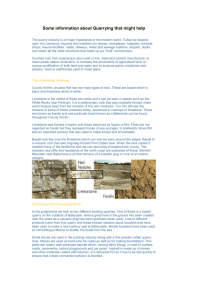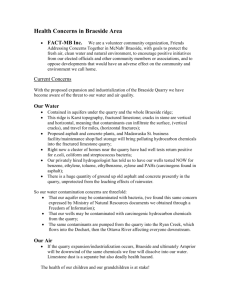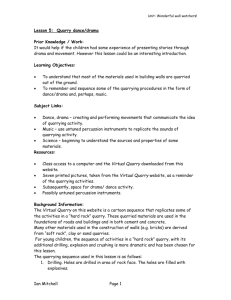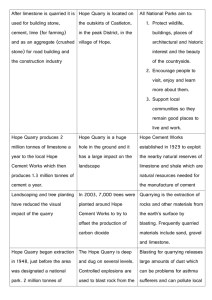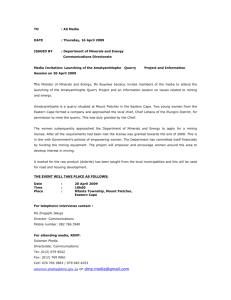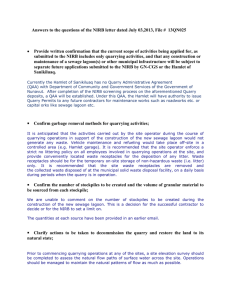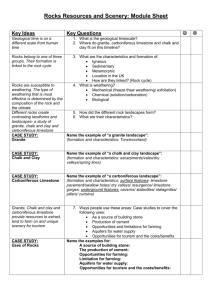Lesson Four - Virtual Quarry
advertisement
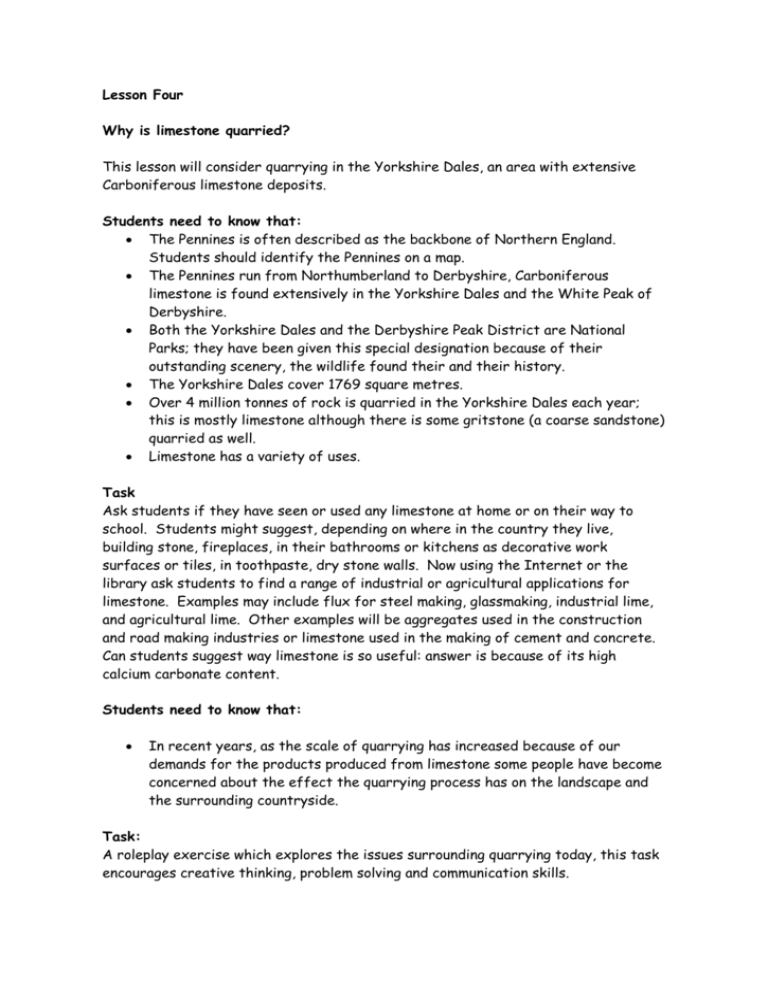
Lesson Four Why is limestone quarried? This lesson will consider quarrying in the Yorkshire Dales, an area with extensive Carboniferous limestone deposits. Students need to know that: The Pennines is often described as the backbone of Northern England. Students should identify the Pennines on a map. The Pennines run from Northumberland to Derbyshire, Carboniferous limestone is found extensively in the Yorkshire Dales and the White Peak of Derbyshire. Both the Yorkshire Dales and the Derbyshire Peak District are National Parks; they have been given this special designation because of their outstanding scenery, the wildlife found their and their history. The Yorkshire Dales cover 1769 square metres. Over 4 million tonnes of rock is quarried in the Yorkshire Dales each year; this is mostly limestone although there is some gritstone (a coarse sandstone) quarried as well. Limestone has a variety of uses. Task Ask students if they have seen or used any limestone at home or on their way to school. Students might suggest, depending on where in the country they live, building stone, fireplaces, in their bathrooms or kitchens as decorative work surfaces or tiles, in toothpaste, dry stone walls. Now using the Internet or the library ask students to find a range of industrial or agricultural applications for limestone. Examples may include flux for steel making, glassmaking, industrial lime, and agricultural lime. Other examples will be aggregates used in the construction and road making industries or limestone used in the making of cement and concrete. Can students suggest way limestone is so useful: answer is because of its high calcium carbonate content. Students need to know that: In recent years, as the scale of quarrying has increased because of our demands for the products produced from limestone some people have become concerned about the effect the quarrying process has on the landscape and the surrounding countryside. Task: A roleplay exercise which explores the issues surrounding quarrying today, this task encourages creative thinking, problem solving and communication skills. Students will consider the difficulties involved in making decisions in areas, such as quarrying, where people often have opposing views. The purpose of the role play will be to enable a group of people involved in the quarrying debate to put forward their views in a calm and reasoned manner. The audience will then be asked to make a decision based on the evidence they have heard, this is not a debate and so those involved in the roleplay will not be expected to argue with each other. The exercise will have 3 stages. Stage 1: Whole class activity to gather initial ideas on quarrying, the need for quarried materials, the impact on the local and the wider environment. Students should be given some guidance where necessary to see that one of the impacts will be economic and that many of the activities taking place in a quarry are governed by planning legislation or national legislation on noise and emission levels. Stage 2: The class is divided into groups of 4. Each member of the group will take a particular role and research that role, gathering information, which will be presented verbally to the whole class. In each group there will be A Quarry Manager A local resident A representative of the National Park Authority A young married man who lives in a neighbouring town with his wife and 2 small children Each person will need to summarise the main points as they see it (in their role, not as themselves) in bullet form to help them in their verbal presentation. The time each group is given to speak should not exceed 10 minutes to encourage each speaker to look at the main issues for their particular area. If your class is large you may want to confine the time to 5 minutes. Stage 3: Following lesson: Presentations of the roleplay exercise to the class. The remaining students will take the role of an audience at a public debate on the issue of quarrying in the National Park. As each presentation finishes they will need to decide which of the speakers would get their vote. This may not necessarily be for the same role each time as a well prepared speaker may well encourage them to pick a different stance each time. Students will be encouraged to consider their own standpoint through a homework task. Information Sheet Quarry Manager You have worked in the quarry industry since leaving school. You think the quarry industry has worked very hard over the last 20 years to use the best technology to ensure they operate in a clean and environmentally sensitive way. Local resident You think the quarry is noisy and dirty. You are worried that the countryside around you will be quarried away. A representative of the National Park Authority. You have to balance the needs of the local community and the economy. In your region most of the employment opportunities are offered by the quarry industry the rest comes form farming or tourism. You realise that the landscape visitors come to see is the landscape that has been created by the quarrying industry. Young family man You know that the country needs the limestone removed from the limestone quarry for a variety of uses, which make the quality of life for everyone so much better. You are however worried about the sustainability of natural resources as you want your children to be able to have a good life in the future. Web Links A useful resource to provide background information on the debate is produced by the Yorkshire Dales Educational Service. It can be downloaded from http://www.yorkshiredales.org.uk/downloads/quarryin.pdf This 4 page resource includes maps showing the distribution of quarries in the Dales and has interesting and informative comments from quarry operators Hanson and comments from local groups. Although in the opening paragraph it is suggested that quarrying activities must inevitably damage the landscape it does go on to show why we need aggregates and what quarry managers do to ensure the landscape is cared for. It looks at restoration and the move to more environmentally sustainable forms of transport. It shows why there is debate about quarrying. www.daelnet.co.uk/news/weekend/weekend_18032005.cfm Has information about prizes won by quarries in the dales for their environmental projects. www.stoneroof.org.uk/cases.htm/ Information about grants being given by the National Park Authority to homeowners in conservation areas who use new stone slates from local quarries www.english-nature.org.uk/special/nnr/nnr_details.asp?NNR_O=92 Scroll down and click on Ribblehead Ribblehead Quarry Walk, Ingleborough National Nature Reserve A walk through a landscape viewed by many as “natural” but which was in fact created as a result of quarrying www.bbc.co.uk/scotland/education/int Scroll down the main page to upland limestone link Click on round table for ideas about roles and then follow the links to profiles of real people, listen to their thoughts To inform the debate students will need to know that: Quarries only have a limited life, either the resource will be completely worked out or the limestone will not be of the same high quality throughout the quarry area and so quarrying will cease. Quarry operators have to apply for permission to extend a quarry or to continue to work an existing site beyond the original date they were given for working it. An example of this is Swindon Quarry near Cracoe, which has been granted permission to continue quarrying until 2020 when it must cease work and carry out planting, and restoration work, which will turn the “hole in the ground” into a nature reserve. Horton Quarry, in Ribblesdale is an example of a quarry with a long working life Hill Top quarry in Swaledale is an example of a quarry that produces a specialist product. Rock from this quarry is used to make stone roofing slates used to restore old buildings in the Dales in a sympathetic manner. Homework Preparation for the roleplay.
